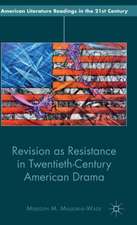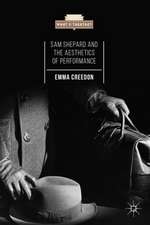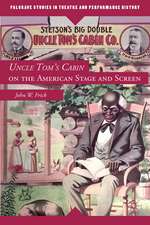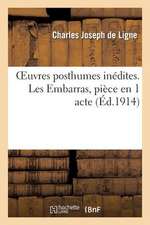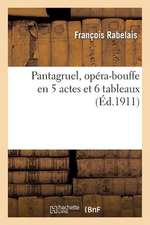Performing Neurology: The Dramaturgy of Dr Jean-Martin Charcot
Autor Jonathan W. Marshallen Limba Engleză Hardback – 14 iul 2016
This text provides a study of Jean-Martin Charcot, a founding figure in the history of neurology as a discipline and a colleague of Sigmund Freud. It argues that Charcot’s diagnostic and pedagogic models, explaining both how disease is recognized and described and how to teach the act of neurological diagnosis, should be considered through a theatrical lens. Considering the constitution of the living, moving body in terms of performance, Charcot created a situation whereby the line between deceptive acting and real pathology, scientific accuracy and creative falsehood, and indeed between health and unhealth, becomes blurred. The physician becomes a medical subject in his or her own display, transforming medicine into a potentially destabilizing, even grand guignolesque, discourse. Offering a unique insight into Charcot’s work, his concepts and his methods, this text represents a unique and interdisciplinary analysis cutting across the fields of art and neurology.
Preț: 729.06 lei
Preț vechi: 889.09 lei
-18% Nou
Puncte Express: 1094
Preț estimativ în valută:
139.51€ • 149.18$ • 116.32£
139.51€ • 149.18$ • 116.32£
Carte tipărită la comandă
Livrare economică 18 aprilie-02 mai
Preluare comenzi: 021 569.72.76
Specificații
ISBN-13: 9781137517616
ISBN-10: 1137517611
Pagini: 288
Ilustrații: XI, 277 p. 11 illus., 1 illus. in color.
Dimensiuni: 148 x 210 x 21 mm
Greutate: 0.49 kg
Ediția:1st ed. 2016
Editura: Palgrave Macmillan US
Colecția Palgrave Macmillan
Locul publicării:New York, United States
ISBN-10: 1137517611
Pagini: 288
Ilustrații: XI, 277 p. 11 illus., 1 illus. in color.
Dimensiuni: 148 x 210 x 21 mm
Greutate: 0.49 kg
Ediția:1st ed. 2016
Editura: Palgrave Macmillan US
Colecția Palgrave Macmillan
Locul publicării:New York, United States
Cuprins
Introduction.- PART 1: PATHOLOGICAL PERFORMANCE: CONTEXTS, FRAMES AND STAGES.- 1. Theatrum Analyticum: The Stage of the Salpêtrière and Its Players.- 2. Materializing the Archetype.- 3. Theatrical Pedagogy.- 4. The Grotesque Body and the Living Nude.- PART 2: PATHOLOGICAL PERFORMANCE IN THE CLINIC.- 5. Performing Hysterioepilepsy.- 6. Infectious Representations.- PART 3: THEATRICAL FICTIONS.- 7. Theatrical Appearances and Degenerative Synaesthesia: Munthe and Daudet.- 8. The Theatre of Horror and Dread.- Conclusion.
Recenzii
“Marshall argues that Charcot is “best understood through the lens of dramaturgy. He demonstrates the spatial and temporal implications of Charcot’s neurological practice as steeped in neo-classical aesthetics and deeply attuned to scenography, showmanship, and stage production. Using convincing evidence drawn from critiques of Charcot, Marshall demonstrates … that the power and danger of mixing medicine and theatrics was not lost on Charcot’s contemporaries.” (Maia Woolner, New Books network, newbooksnetwork.com, May, 2018)
“Drawing on a range of textual, artistic, architectural, and photographic materials, Marshall offers a vivid analysis of Charcot’s neurological dramaturgy from the laboratory to the lecture hall. … Marshall’s compelling study troubles neat distinctions between theatre and medicine, knower and known, rational and irrational, and pathology and health in and beyond the space of Salpêtrière, as theatricality moves center stage in this rich archaeology of neurological practice.” (TDR: The Drama Review, Vol. 62 (3), 2018)
“This is an erudite cultural history that encompasses medicine, visual art, cultural thinking and theatre in the later decades of the nineteenth century in a thoughtful analysis that integrates these divergent elements fluently. Ambitious in its scope, at the same time the book is highly detailed and impresses with its descriptions of the medical and artistic milieu surrounding major figures. ” (Peta Tait, Australasian Drama Studies, Vol. 71, 2018)
Translated from French:
“Moving through the different sites for the constitution and exercise of the Charcotian dramaturgy, Marshall offers a new course through which to look at the master [Charcot]’s thinking … [Marshall] brings the rich contributions of theatrical theory and art history to the analysis of Charcotian works, illustrated for example by the study of the paintings of the Salpêtrière and their strategic use … Overall, Marshall’s work is for the cultural historian an interesting immersion in the work and methods of Dr. Charcot, offering a unique perspective on this major neurologist whose immense oeuvre remains even now, by and large, for us yet to discover and study.” (Alexandre Klein: H-France Review, Vol. 17 (134), August, 2017)
“Drawing on a range of textual, artistic, architectural, and photographic materials, Marshall offers a vivid analysis of Charcot’s neurological dramaturgy from the laboratory to the lecture hall. … Marshall’s compelling study troubles neat distinctions between theatre and medicine, knower and known, rational and irrational, and pathology and health in and beyond the space of Salpêtrière, as theatricality moves center stage in this rich archaeology of neurological practice.” (TDR: The Drama Review, Vol. 62 (3), 2018)
“This is an erudite cultural history that encompasses medicine, visual art, cultural thinking and theatre in the later decades of the nineteenth century in a thoughtful analysis that integrates these divergent elements fluently. Ambitious in its scope, at the same time the book is highly detailed and impresses with its descriptions of the medical and artistic milieu surrounding major figures. ” (Peta Tait, Australasian Drama Studies, Vol. 71, 2018)
Translated from French:
“Moving through the different sites for the constitution and exercise of the Charcotian dramaturgy, Marshall offers a new course through which to look at the master [Charcot]’s thinking … [Marshall] brings the rich contributions of theatrical theory and art history to the analysis of Charcotian works, illustrated for example by the study of the paintings of the Salpêtrière and their strategic use … Overall, Marshall’s work is for the cultural historian an interesting immersion in the work and methods of Dr. Charcot, offering a unique perspective on this major neurologist whose immense oeuvre remains even now, by and large, for us yet to discover and study.” (Alexandre Klein: H-France Review, Vol. 17 (134), August, 2017)
“The potential readership for this new book is quite broad, and interested readers new to the topic will profit, but also those who are familiar with the large literature on Charcot but open to new perspectives will find insightful reading within this very well-organized book. … Contemporary neurologists … will learn from this analysis and reflect on their own practice and teaching methods with a greater sensitivity to verb and tense as we ‘perform’ our neurological examinations daily.” (Christopher G. Goetz, Brain: A Journal of Neurology, Vol. 140 (6), June, 2017)
Notă biografică
Jonathan W. Marshall, born on February 22, 1970, is an interdisciplinary scholar who has published on the relationship between neurology and the arts, as well as photomedia, sound art, butoh dance, Australian painting and choreography, and other topics. Marshall is a freelance critic and reviewer of contemporary arts. He is currently based at the West Australian Academy of Performing Arts, Edith Cowan University, Perth.
Textul de pe ultima copertă
This text provides a study of Jean-Martin Charcot, a founding figure in the history of neurology as a discipline and a colleague of Sigmund Freud. It argues that Charcot’s diagnostic and pedagogic models, explaining both how disease is recognized and described and how to teach the act of neurological diagnosis, should be considered through a theatrical lens. Considering the constitution of the living, moving body in terms of performance, Charcot created a situation whereby the line between deceptive acting and real pathology, scientific accuracy and creative falsehood, and indeed between health and unhealth, becomes blurred. The physician becomes a medical subject in his or her own display, transforming medicine into a potentially destabilizing, even grand guignolesque, discourse. Offering a unique insight into Charcot’s work, his concepts and his methods, this text represents a unique and interdisciplinary analysis cutting across the fields of art and neurology.




